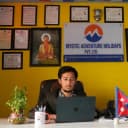Difficulty level of 2026 trek
The difficulty level of the Langtang Valley view trekking is graded as a moderate trek. It is because of the various factors that challenge you during the trek in the Langtang trekking route. The trek spans 10 days. The Langtang Valley trekking distance is 57 km, with average walking hours up to 6-7 hours per day.
The highest altitude reached during the trek is 4,773 m at Kyanjin Ri. To reach that level, one has to walk through the trails featuring a mix of well-maintained paths and rugged sections, including steep ascents and descents.
People with no prior trekking experience and those with average fitness levels can go for the trek, as the trek is manageable. A complete beginner may find certain sections challenging. The itinerary is designed for all trekkers.
Best time to go for 2026 trek
The best time to go for the Langtang Valley trekking is from September to mid-December and March to May. These months provide favorable weather conditions for trekking with less precipitation, chilly mornings and evenings, and clear skies.
Also, in these months, the crowds are more so, and the Langtang Valley trekking price will be a little higher than usual.
If planned thoroughly and with the right gear, you can also go during the summer or winter season. You just have to be prepared for the heavy rainfall and muddy trails during the summer and cold temperatures and snow during the winter season.
Permit requirement for 2026 trek
The permits required for the 10-day Langtang Valley trek are the Langtang National Park Permit and TIMS Card (Trekkers' Information Management System). Both of these permits can be obtained from the Nepal Tourism Board in Kathmandu or through registered trekking agencies.
To get these permits, you will need your passport and visa and to pay the fee at the time of application. And the online application of some permits may not be available. In addition, the expenses of the permits are included in the Langtang Valley trek cost.
If you want to fly the drones in this region, you will need a drone permit. Learn more about the drone laws in Nepal from the link.
Accommodation, food, and drinking water during 2026 trek
During the trek to Langtang Valley, there are diverse accommodation options available, like teahouses and lodges. You will be staying in a standard teahouse available along the Langtang trekking route.
In the case of food items, you can have options like Tibetan bread, chapati with jam or honey, pancakes, porridge, and omelets for breakfast; dal bhat, fried rice, pasta, and momos (dumplings) for lunch; and dal bhat, various noodle dishes, apple pie, or rice pudding for dinner.
You can buy bottled water for drinking along the trail unless you reach the last village for the 10-day Langtang Valley Trek. We suggest you bring your bottle and refill it with the water of your choice in hotels and tea houses to reduce plastic waste on the trekking trail. Sometimes you have to walk in a deep forest where there are no tea houses. At that time, you need to use free-flowing water for drinking, so bring iodine or water-purifying medicine for safe drinking water.
The availability of toilet and shower facilities varies depending upon the altitude level and specific teahouses. In the lower altitudes, the most common type of toilet is the Western-style toilet, while the squat toilet is more common in the higher altitudes along the Langtang trekking route.
Furthermore, the shower facilities are mostly available in most of the teahouses. The methods may be different, like a bucket shower. The proper showerhead is rarely available in the teahouses. For the hot shower, you have to pay the additional money, as it is not included in the Langtang Valley trekking cost inclusions.
Electricity, telephone, and Internet availability 2026
The electricity is available in most of the teahouses throughout the trek. In the lower altitudes, the settlements are connected to the national grid, while at the higher altitudes, the source of electricity is solar power. Device charging is available in all teahouses at a small cost.
The mobile network coverage is available up to Kyanjin Gompa. You can use the local SIM cards of NCELL and NTC. The network may not be available at all the altitude levels and weather conditions.
In the case of the internet, there are Wi-Fi services available in most of the teahouses. However, during the trek to Langtang, you should be prepared for the potential disconnection from the internet. The mobile data is also not so reliable in all the places.
Altitude sickness issues and acclimatization strategies
The altitude sickness issues can occur during the Langtang region trekking, whether it is 10-day Langtang Valley trekking or Langtang Gosaikunda trekking. It may be because of the Langtang Valley trek distance.
The common symptoms seen in the Langtang Valley trekkers are headaches, dizziness, nausea, loss of appetite, and fatigue. The acclimatization strategies include gradual ascent, incorporating acclimatization days into your itinerary, hydration, nutrition, and so on.
Overall Weather and temperatures of the langtang region
The weather and temperature during Langtang trekking can vary based on the altitude level and seasons. The lower elevations are generally warmer than the higher elevations on the Langtang trekking route. Here is the seasonal breakdown of the weather and temperature during the Langtang Valley trekking journey.
- Spring: The daytime temperature ranges from 10°C to 20°C (50°F to 68°F), and the nighttime temperature ranges from 0°C to 5°C (32°F to 41°F). The weather conditions during spring are stable and have less rainfall.
- Summer: The daytime temperature can go up to 25°C (77°F) from 15°C (59°F), and the nighttime temperature can drop to 10°C (50°F) from 15°C (59°F). The weather is unstable, and it may rain anytime, and it is frequent. The skies may be covered with the clouds before rain.
- Autumn: In this season, the average daytime temperature is 15°C (59°F) (range 10°C to 20°C), while the nighttime temperature can drop below 5°C (41°F) (range 0°C to 5°C). The weather is stable with clear skies and less rainfall.
- Winter: The overall weather is cold with a chance of snowfall in the higher altitudes. The mornings are foggy, and the conditions can change rapidly. The daytime temperature ranges from 5°C to 10°C (41°F to 50°F), and the nighttime temperature ranges from -10°C (14°F) to -15°C (5°F).
For the real-time info, you can also use the weather forecast apps.
Flight, transportation, and luggage info 2026
When going on the Langtang Valley trekking for 10 days, you should be serious about flight prebookings, transportation planning, and luggage packing. Below is some useful information regarding flight transportation and luggage for the trek to Langtang Valley.
- International and internal flights
If you are traveling from abroad, then you will need a visa and passport to enter Nepal. Visa on arrival is only for some countries. So, check your eligibility for the visa on arrival before booking the flight.
You can carry 23 kg, including your hold baggage and hand luggage, on your international flight. For the extra weight of the duffel bag or daypack, you have to pay an extra amount of money.
- Luggage needed for the trek
You must have a duffel bag of 80 Ltr capacity, and a 50-65 Ltr backpack is enough for carrying essential equipment like gear and other items. Typically, the porter will carry the duffel bag while you are responsible for carrying your backpack. You may need a small, 20–30-liter day backpack to carry your essentials during the day’s hike.
Group Leader and Crew for 2026 season
We, Mystic Adventure Holiday, provide a certified and experienced guide along with local staff. If we have more than 8 guests for the Langtang Valley trek of 10 days, we will arrange for a porter to carry your luggage. One porter will carry the bags of 2 guests.
The expenses of the group leader and crew are included in the Langtang Valley trekking cost inclusions. The tour guide will have the Langtang Valley map for navigational purposes.
Trekking Equipment suggestions 2026
Trekking gear and equipment play a key role in the comfort. And success of any trip, including the trek to the Langtang Valley and Kyanjin Gompa.
- Trekking equipment, including a 40-50 liter backpack, sleeping bag, trekking poles, headlamp, hydration system, and duffel bag.
- Clothing like moisture-wicking long-sleeved shirts, fleece jackets or down jackets, waterproof and windproof trekking pants, thermal bottoms, hiking boots, hiking socks, and flip-flops/sandals.
- Accessories include a warm hat and gloves, a sun hat and sunglasses, a bandana or buff, and so on.
- Essential documents like a valid passport with photocopies, a trekking permit, travel insurance, and passport-sized photos.
- Miscellaneous items, including a trekking map/guidebook, a camera and extra batteries, a portable charger/power bank, snacks, and a travel adapter.
- Health and safety items like first aid kits, including necessary medication, water purification tablets/filters, and so on.
Customize Itineraries and Trip Extensions for 2026 season
The Langtang Valley trek itinerary can be customized, and trips can be extended further based on your preferences and fitness level. The customization of the trek itinerary means extra days for acclimatization, side trips to nearby landmarks, and so on.
The trip extensions include visiting the nearby villages, monasteries, or viewpoints, or even extending your trek to include other destinations. As a mystic adventure representative, we will organize, customize, and extend your trekking journey through the Himalayas.
Tips to make 2026 trekking journey smooth
- Understand the terrains and weather conditions of the Langtang Valley for the greater experience, and use the Langtang Valley Trek map if necessary.
- Build endurance through cardio workouts and strengthen your legs.
- Include all the guide’s recommended gear so that you can complete the trek comfortably.
- Stay hydrated and listen to your body signals to prevent the altitude sickness issues.
- Consume the balanced diet that fulfills all the basic nutrient requirements.
- Engage with the Tamang community respectfully and respect their culture and traditions.
- You will need a little extra cash on hand during the trek to buy additional beverages, snacks, etc., so withdraw extra cash in Kathmandu, as there is no ATM along the Langtang trekking route.
- Carry a solar charger or power bank for your electronic devices.
- Don't get shy and try to ignite normal conversations with locals. Who knows, they'll share some interesting stories?
- Always ask for permission before taking photographs of people or any sacred sites.
- Become a responsible traveler and carry a reusable water bottle. You can refill drinking water on the Langtang trekking route.
- The Langtang Valley trek for 10 days without a guide is not possible, according to the new rule implemented on April 1, 2023. The Nepali government has made it mandatory for all international trekkers to have a licensed guide for hiking the Langtang Valley.
- If you get confused about tipping, then follow this advice: USD 100 to the guide & porter, USD 5 to the tour guide, and USD 2 to the driver (for each member of the group).













